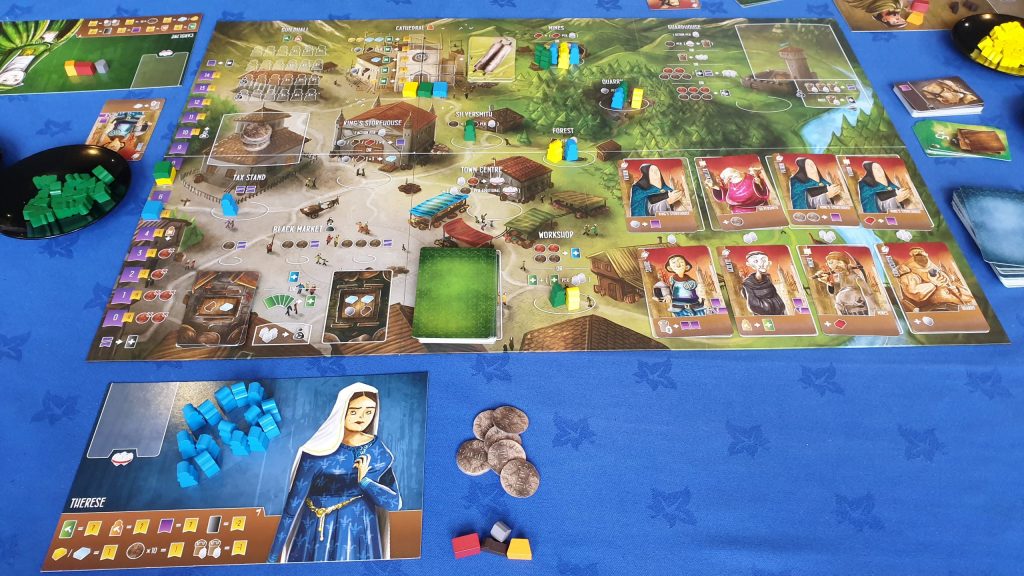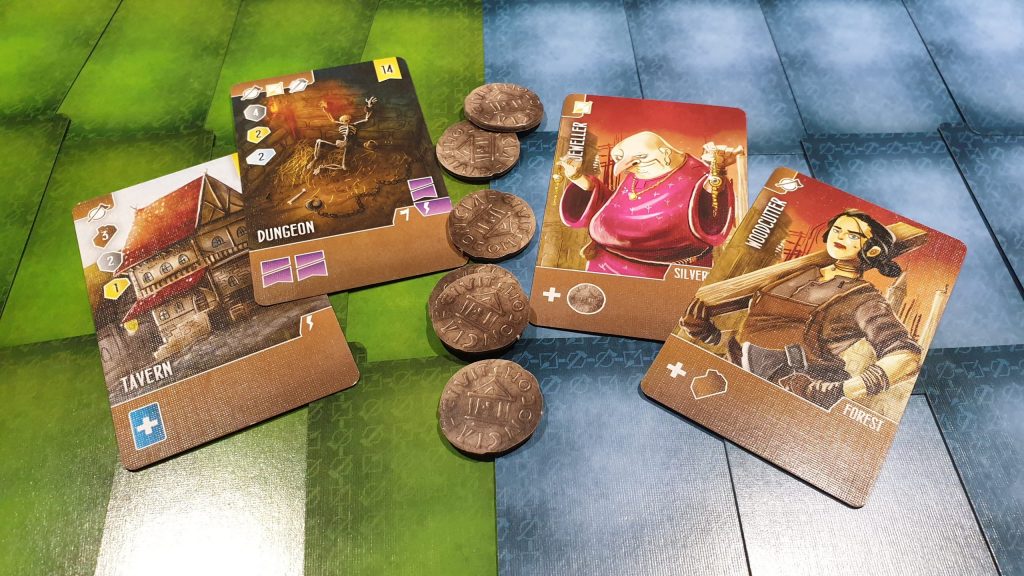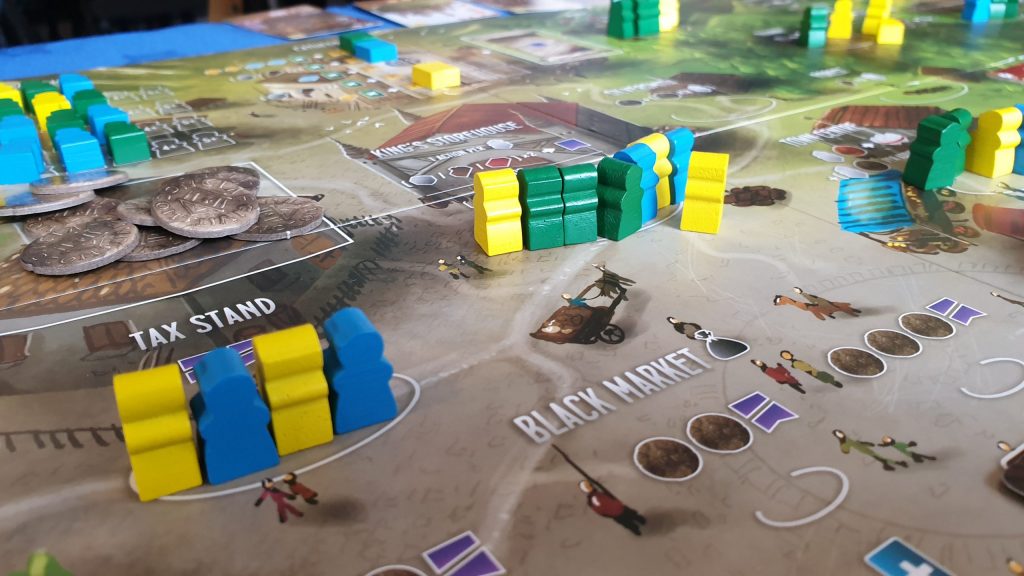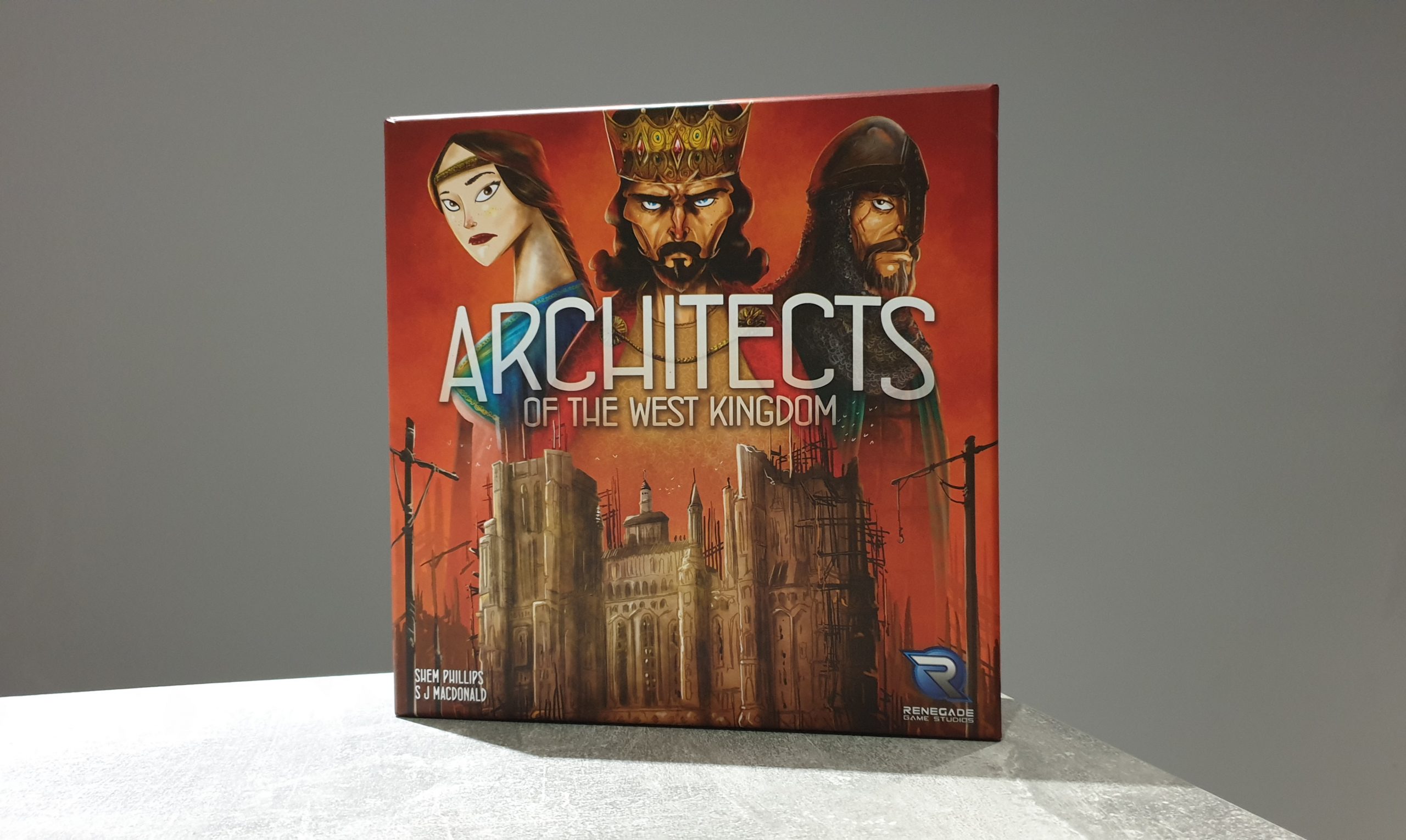Architects of the West Kingdom is a worker placement based, strategy, board game from publisher Garphill Games. Designed by Shem Phillips and S J Macdonald, featuring artwork from Mihajlo Dimitrievski, the game sees 1 – 5 players become architects for just over an hour. Using resources, buildings will be constructed, workers will be imprisoned and taxes will be stolen or skipped. However, with somewhat of a moral or ethics tracker, is this an experience to get stuck into? Let’s find out.
Instantly differentiating itself from other worker placement games, players start Architects of the West Kingdom with 20 worker meeples. Alongside this, each player has three coins to their name, a player board and are dealt 4 building cards. Before the game starts, a round of drafting occurs. Looking at the four buildings dealt to them each player chooses 1 and passes the rest on to the next player. This passing and choosing repeated until all players have three cards with the final card returned to the bottom of the building deck.
On a turn a player will take a worker from their available pool and place it onto a space on the board. To gain resources players can send a worker to the mines for clay or gold, the forest for wood or the quarry for stone. To gain coins players can visit the silversmith or they could, at the expense of virtue, steal the coins from the tax stand. In a similar vein resources can be obtained from the black market, for coins and virtue. The black market spaces are the only slots that are for only 1 worker, with the three slots full triggering a market refresh.
Once players have resources they will want to work towards buildings, apprentices or perhaps contribute to building the cathedral. Apprentices can be obtained by sending workers to the workshop. This is a 2 x 4 grid with players able to take from the left most two for free or pay 1 gold onto cards skipped. The same workshop space can be used to instead draw a building card.

Apprentices come without a resource cost but can have instant effects, virtue opportunities, worker space upgrades or a mixture. Most common are the worker space upgrades. For example, the woodcutter intuitively adds 1 wood to the resources taken when the gain wood action at the forest is used. Each worker comes with a specialty and most buildings require the player to have at least one apprentice of a specific specialty type to be built. Each building naturally requires resources, with tokens returned back to the bank. Buildings can reward the player with instant rewards and/or end game scoring opportunities. On top of the cost, to build a building the player permanently gives up a worker to the guildhall track.
This same track is used for when players wish to contribute to the cathedral. Doing so gains the player a small instant reward, often boosting a player’s virtue, and points at the end of the game. This guildhall track acts as the game tracker, with only so many slots available before the final round of the game is triggered – with the amount of slots depending on the player count.
Architects of the West Kingdom breaks another board gaming norm by not having rounds. Therefore, players don’t arbitrarily get their workers back. This builds into two different elements of the experience that truly steps the game up to get excited cogs turning. Whenever a player sends a worker to a multiple placement space it improves the action. Be it more resources being produced, better options or just the ability to perform multiple actions – this is a huge element of the game players need to watch out for opportunities from.

This is where the Town Center space enters play. By sending a worker to this location and paying the coin cost a player can round up all the worker meeples from one player from any one action space. If they are their own they are simply returned to the players pool of available workers. If they are opponents’ they become captured. Once a player has some captured workers, taking these hooligans to the prison sees coins earnt. At the prison players can free their own workers or pay to break their captured meeples free from other players. The circle of using, capturing, freeing and reusing workers then continues.
The virtue track opens up strategies and balances some of the better actions. This adds a new angle of timing into the mixture of things players must consider. Specific action spaces become blocked depending on your virtue. Become too dodgy and you won’t be able to contribute to the cathedral. Become too honourable and the black market won’t sell to you. Therefore, the order players perform actions can result in an action taken just in time before becoming unavailable. The other aspect of timing stems from action spaces like the tax stand. Taking a 2 virtue hit for a few coins isn’t ideal. Wait it out and there could be a big payday for the same cost, though you’ll have to beat your opponents to it. This drives trade offs, with players having the choice whether or not to be unvirtuous.
At the end of the game points are gained or lost based on player’s positions on the virtue track. However, there are many other ways to gain points. Buildings, stages of the cathedral, gold, marble and unspent coins can all gain players points. At the same time debts players can acquire lose points, along with pairs of workers remaining in prison. At the end of the game whoever has the most points wins!
For those that dislike the solo gaming feel of some worker placement titles Architects of the West Kingdom may be the answer. Every turn there is the opportunity to interact with others, not often via blocking, but by capturing workers. Players can again pick their timing to scoop up a huge number of opponent owned workers. Given that most actions improve based on the number of workers this can impact others greatly. Once this capturing war has started it rarely stops either, leading to a highly interactive worker placement experience.

If you are wanting a truly strategic experience this may put you off. Architects of the West Kingdom is much more about tactically reacting to the best options. Be it swooping in for an apprentice or visiting the black market for the exact goods needed. Players can enter the game and go for different strategies though, be it a black market criminal route or a hearty cathedral builder. You won’t be able to do it all, so players will have to focus on different aspects to reap rewards.
The artwork isn’t for everyone. It is a rather unique style, that uses colour nicely but does lack detail. To those initially unsure on the style I was in this camp but it did grow on me while playing, and it is nice to see it continue across the series. Regardless of artwork, the cards are laid out extremely well – allowing all of the information to be easily digested. The use of symbology that causes this extends across the rest of the components making the experience significantly smoother to play. The board features the same style artwork, tying the game together. On top of this, the resource tokens are all nicely shaped and help give the game a premium feel, with the whole package storing neatly in a smaller than expected box.
Architects of the West Kingdom thrives on the interaction between players. As a result the game can, at times, fall a little flat with 2. If you’re looking for a worker placement game where you can do your own thing there are many games out there for you, for example the wonderful Viticulture. Therefore, if you are playing Architects of the West Kingdom it is because you want that interaction, thus additional players are needed. The artwork may not be to everyone’s taste but it isn’t offensive to the eyes: certainly not when the gameplay will have you watching what others are doing as much as looking head down at the board. While many worker placements slow to a plod with an increasing player count, Architects of the West Kingdom is a great experience to break that mould!
((Editor’s Note: Architects of the West Kingdom was provided to us by Asmodee for the review. The game is currently available from local board game stores, find your local store here.)

